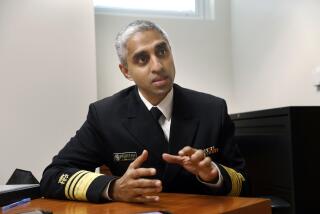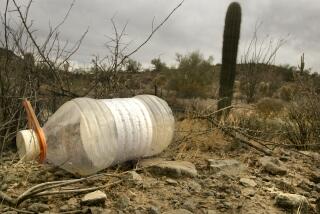Call to Duty : Medicine: Jolted by the plight of victims of civil wars worldwide, more U.S. medical professionals are offering to serve in political trouble spots and remote communities.
At 7 a.m. Dr. Rob Johnson, a 56-year-old orthopedic surgeon from Corona, steps out into the broad courtyard of a small hospital in Mogadishu, the war-racked capital of Somalia.
Two continents away from the spic-and-span corridors of Loma Linda University Hospital, where he normally operates, Johnson surveys an acre of ground, much of it covered by the mangled bodies of the wounded and dying.
A volunteer with the Los Angeles-based International Medical Corps, he has come to minister to victims of one of the world’s most devastating yet forgotten catastrophes: the tribal strife that is tearing apart the countries of the Horn of Africa.
Johnson begins each day by deciding who will have a chance to survive.
Threading his way through the crowd, he searches out likely candidates for surgery. He passes by those with compound fractures where infection has led to tetanus and death is certain. Their bones shattered by high-velocity missiles, many have lived with their wounds for days.
“We’ll just have to wait,” he tells them gently.
He also passes those with head injuries; the masses of casualties are too overwhelming to permit complex surgical procedures that consume precious time and medicine.
Occasionally a small group will surge forward, imploring Johnson to take a loved one. Once in a while he will consent, re-wrapping a bandage where a portion of skull is hopelessly missing--simply to ease the family’s anguish.
Then he chooses the morning’s first three or four patients. He will come out nine or 10 more times during the day, picking others, performing up to 40 operations, working until early the following morning. Then, after a few hours of sleep, he will begin all over again.
As the first anniversary of the Persian Gulf War approaches, the new year finds an estimated 1,500 to 2,000 Americans engaged not in hostilities but in medical relief work around the world, helping to save lives and heal disease-ridden communities.
The work can be dangerous. At times, medical supplies run perilously low, and living conditions are often miserably basic.
Still, jolted by the slaughter of the Kurds in the aftermath of the Gulf War as well as by an array of independence movements in Eastern Europe, more American medical professionals have been offering to leave homes, jobs and families for short-term service in political trouble spots and remote communities.
“There has been an extraordinary response,” declares Robert De Vecchi, head of the International Rescue Committee, which has close to 200 doctors and nurses in refugee crisis areas.
Since the Kurdish emergency, French-based Medecins sans Frontieres (Doctors Without Borders), the largest international medical relief organization, has received more than 500 applications from American physicians as well as from nurses and logistics experts. The group opened a Los Angeles office last month.
The positive response has prominent relief agency officials questioning whether the United States has indeed succumbed to “compassion fatigue,” also known as donor burnout--the notion that the public is weary of aiding destitute populations around the globe.
“People are tired of giving to alleviate starvation in Africa when the next year they’re starving all over again,” notes Myra Taylor, a spokeswoman for the International Medical Corps. “But I don’t find that in the medical field.”
Along with observing an awareness of international issues, international relief officials say they sense a new spirit of idealism among doctors fed up with thinking of patients as mere customers, not suffering people.
“I hear it more and more,” says Nancy Kelly, executive director of Health Volunteers Overseas, which recruits doctors to teach and practice in Africa and Asia. “They say, ‘I’m tired of the business, I’m tired of the paperwork, the liability, the defensive practice you have to have here. I want to get back to medicine.’ ”
It was such professional exhilaration that inspired Johnson to work under the appalling conditions he found in Mogadishu, where he spent the month of November.
“To be able to do what you do best is very rewarding. You were trained precisely for such a time as this,” he affirms.
A veteran of other medical missions and a doctor during the Vietnam War, Johnson nonetheless admits that he was not prepared for the bloodshed produced by the tribal warfare that has raged for a year in Somalia.
From a practice in reconstructive surgery, he plunged into military medicine practiced at what he estimates was about 10 times the pace of an American hospital emergency room.
“They’d pile up outside the entrance to the hospital,” he says of the wounded. “I’d choose on the basis of how quickly and easily the job could be done.”
Arriving with a team of 11 Americans, Johnson found the hospital he had been assigned to had been looted--even the beds were missing. And, with no electricity, surgery was performed at night by flashlights.
The only fully operational hospital was run by Doctors Without Borders, but warfare prevented most planes and boats from landing at the seaport city, supplies were cut off and fresh doctors were unable to replace the team of surgeons that had recently departed.
During his stay, Johnson was the only specialist in bone surgery in the city, the only one trained for warfare’s most prevalent procedure: amputation. His work was done in one of two operating rooms and, at times, in the hallway. After an hour in the small recovery room, postoperative patients were put out under tents in the courtyard. Before Johnson left, most of the antibiotics and anesthesia had been used; there were no painkillers to administer before or after surgery.
“They’re patient, darling people--tough, uncomplaining, real tough,” he says, remembering the Somalians he treated.
He recounts how he amputated a young man’s shattered leg without so much as a shot of whiskey: “I said, ‘Look, you’re going to die unless you do this. I’ll do it real fast and be real careful. He said OK and grabbed the handles of the stretcher. It only took about 10 minutes.’ ”
Among those he could not save, Johnson remembers a 3-year-old girl hit by a fragmentation bomb. She had internal injuries and was missing a leg and an arm. Left outside the hospital door, she died before nightfall.
“That’s how lonely it was for the patients and me at critical times--and how terribly sad,” Johnson says.
Indeed, emergency relief officials caution that not everybody who wants to volunteer is suited for risky front-line service.
Despite its 20-year history and an average of 2,000 medical personnel sent annually to 62 countries, Doctors Without Borders has lost three volunteers in the Sudan and Afghanistan within the last two years. In October, two nurses were wounded in a medical evacuation convoy in Yugoslavia.
In its first major U.S. campaign, Doctors Without Borders has chosen only 50 of the 500 applicants to undergo final recruitment procedures in February, with scheduling, medical background, language and personality among considerations, says Chantal Martell, who directs the U.S. operation.
“You don’t just walk off the plane and say, ‘Hey, here I am. I want to help,’ ” adds Dr. Russell Morgan, head of the National Council for International Health, the country’s leading information and advocacy group.
Drawbacks notwithstanding, recruits often set out with a combination of idealism and bravura.
Pamela Craig, a former general surgeon at San Gabriel Valley Medical Center, for instance, has signed up for war-zone service with Doctors Without Borders, declaring, “I have no problem with that.”
“I figure I’ll take care of myself the best I can,” says Craig, 45.
Still, first-time volunteers returning from war zones typically tell of moments of unnerving fear.
David Servan-Schreiber, a 30-year-old Pittsburgh neuropsychiatrist who spent five weeks last summer in Kurdistan, says: “It gets frightening.”
During a 10-hour trip from Baghdad to the remote mountain outpost where he served, Servan-Schreiber’s party passed numerous Iraqi checkpoints. “You don’t know exactly what’s happening,” he recalls. “Every turn in the road is covered by machine guns.”
On the way, the medical team met volunteers on the route home. “Some of them didn’t make it for more than a few days because they were too scared,” he says. “They described horrible conditions.”
And their accounts were hardly exaggerations, Servan-Schreiber learned.
He describes the hospital where he was stationed as “a shanty building” with no running water, no electricity, a continuous stench of vomit and fly-infested wards. On an average day, about 1,000 people--many of them teen-age soldiers--crowded the corridors for treatment.
But Servan-Schreiber, who calls his urgent impulse to help the Kurds “a fever,” was rewarded, just as Johnson was, by the thrill of feeling “incredibly useful.”
“You had your hands, your stethoscope and your clinical judgment,” he says of the rudimentary conditions.
Away from fast-paced, high-technology medicine, he also found time to be close to his patients. “Sometimes I had two or three hours to be with a child who was dying, just holding their hand,” he says. “That felt like why I went to medical school in the first place.”
If volunteers receive a dose of self-satisfaction, their experiences also can have valuable application in rural and inner-city medical practice in the United States, relief officials point out.
“We shouldn’t have our heads stuck in the sand and think we’ve invented the wheel,” says the National Health Council’s Morgan, enumerating American problems--from nutrition to poor maternal health--that parallel those in developing countries.
For Patrick Kachur, a first-year resident at the Johns Hopkins University School of Hygiene and Public Health, a seven-month stay in Nigeria, sponsored by the American Medical Students Assn., determined his career goal.
Based at the government-run medical school in Ilorin in southwestern Nigeria, Kachur was shocked that students lacked individual textbooks. He marveled, however, that before they began their medical training they learned to approach their less sophisticated rural countrymen as part of their health curriculum.
In the American medical system, Kachur points out, “it’s not until we’ve amassed a body of scientific minutiae that we ever see our first patient.”
Tending victims of Guinea worm disease, a water-borne parasitic illness that afflicted residents of a local village, Kachur became intensely aware of the social and racial barriers that separated him from the people he had come to help.
The disease had been so endemic to the community for so many generations that, Kachur says, “it was considered a natural part of a person’s body. They would point to ropy veins on my legs and arms and say, ‘See, you have them, too. They just haven’t come to life.’ ”
Kachur was astounded that despite villagers’ superstitious beliefs, they were willing to change their habits.
“I don’t understand that yet. But that’s what I want to do with my career now,” says Kachur, who is now doing his clinical work in sexually transmitted diseases in Baltimore’s inner city. “I want to empower people to take that kind of attitude.
“It doesn’t require technology. It doesn’t require equipment. It requires a capability to deal with people and their culture.”
More to Read
Sign up for Essential California
The most important California stories and recommendations in your inbox every morning.
You may occasionally receive promotional content from the Los Angeles Times.










